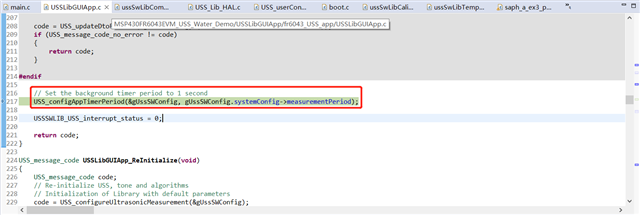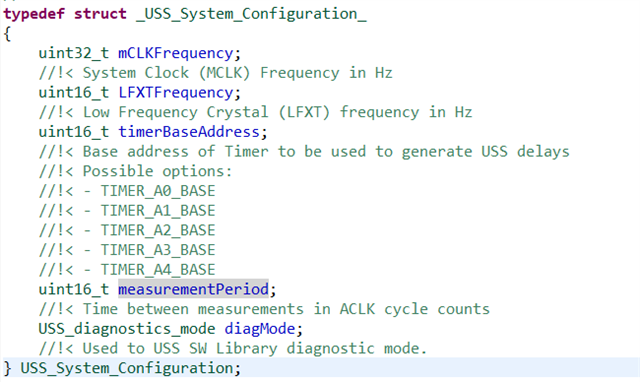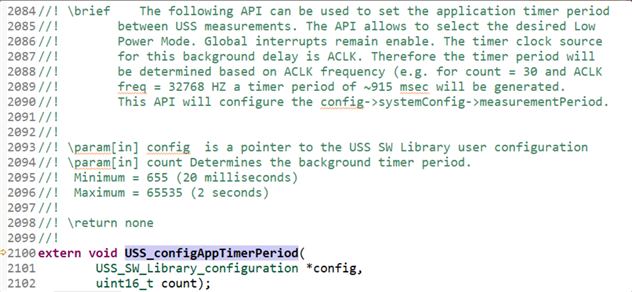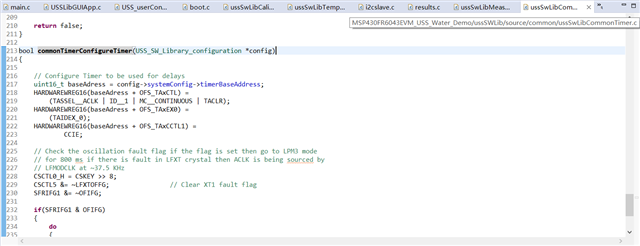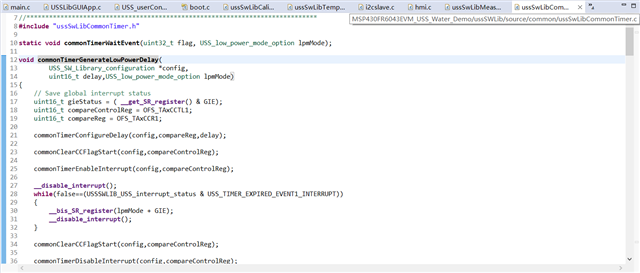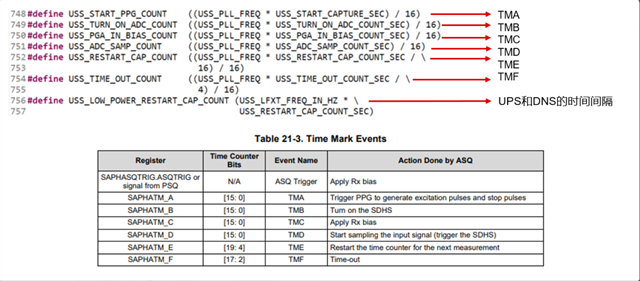使用的例程是MSP430FR6043EVM_USS_Water_Demo,单步调试的时候跳到了common->DesignCenter->comm->drivers->i2cslave.c中的I2CSLAVE__EUSCI_VECTOR中断,看不懂这个中断在传输什么数据。
#pragma vector=I2CSLAVE__EUSCI_VECTOR
__interrupt void I2CSlave_ISR(void)
{
uint8_t ui8Data;
uint16_t u16Temp;
switch (__even_in_range(I2CSLAVE__EUSCI_IV, USCI_I2C_UCTXIFG0))
{
case USCI_I2C_UCSTTIFG:
//
// Check for the repeated start case. If this is a repeated start
// and the previous operation was a write to this device,
// handle the written (received) data. If this is a first-time stard,
// the previous I2C state is eI2CSlaveIsIdle.
//
if (g_I2CSlaveStatus == eI2CSlaveIsBeingWrittenTo)
{
if (I2CSlave_handleEndOfReceive() == true)
{
__bic_SR_register_on_exit(I2CSLAVE__LPMx_bits);
}
}
//
// Reset the I2C Index to zero to begin the new transaction.
// Then check the I2C mode (read/write) to determine
// the transaction mode.
//
g_ui16I2CIndex = 0;
if (EUSCI_B_I2C_getMode(I2CSLAVE__EUSCI_B_PERIPHERAL)
== EUSCI_B_I2C_TRANSMIT_MODE)
{
//
// If this is a read operation (read from this device),
// cancel the slave request flag and trigger and active
// exit to alert the application that the flag has changed.
//
g_I2CSlaveStatus = eI2CSlaveIsBeingRead;
g_bI2CSlaveRequestPending = false;
__bic_SR_register_on_exit(I2CSLAVE__LPMx_bits);
//
// If the driver is set up to send the number of bytes to be read
// before the rest of the buffer, load the number as the first data byte.
// Otherwise, load the first byte of the transmit buffer into the peripheral.
//
if (g_pI2CSlavePort->bSendReadLengthFirst == true)
{
ui8Data = g_ui16I2CLength;
}
else
{
ui8Data = g_pI2CTransmitBuffer[g_ui16I2CIndex++];
}
EUSCI_B_I2C_slavePutData(
I2CSLAVE__EUSCI_B_PERIPHERAL,
ui8Data
);
}
else
{
//
// If this is a write operation (write from master to this device),
// update the status accordingly and continue (no additional action is necessary).
//
g_I2CSlaveStatus = eI2CSlaveIsBeingWrittenTo;
}
//
// If the slave timeout feature is enabled, schedule a
// transaction timeout.
//
#if (I2CSLAVE__TIMEOUT_ENABLE==true)
Timer_scheduleDelayedFunction(eTimerDelayedFunction_B);
#endif /* I2CSLAVE__TIMEOUT_ENABLE==true */
break;
case USCI_I2C_UCSTPIFG:
//
// If the timeout feature is enabled, cancel
// the transaction timeout as the operation
// has finished successfully.
//
#if (I2CSLAVE__TIMEOUT_ENABLE==true)
Timer_cancelDelayedFunction(eTimerDelayedFunction_B);
#endif /* I2CSLAVE__TIMEOUT_ENABLE==true */
if (g_I2CSlaveStatus == eI2CSlaveIsBeingWrittenTo)
{
//
// If the operation that is ending was a write to this
// device, handle the written (received) data, and exit
// active if the callback function requested it.
//
if (I2CSlave_handleEndOfReceive() == true)
{
__bic_SR_register_on_exit(I2CSLAVE__LPMx_bits);
}
}
else if (g_I2CSlaveStatus == eI2CSlaveIsBeingRead)
{
//
// If the opreation that is ending was a read from this device,
// exit active in case a transmit (read) buffer pointer update
// was pending upon this read.
//
__bic_SR_register_on_exit(I2CSLAVE__LPMx_bits);
}
//
// Set new status to idle, as the I2C transaction has stopped.
//
g_I2CSlaveStatus = eI2CSlaveIsIdle;
break;
case USCI_I2C_UCRXIFG0:
//
// Grab the received (written) byte from the I2C peripheral.
// If there is receive buffer space left, store the received
// byte in the receive buffer. Otherwise, discard it and call
// the error callback fxn if one is registered.
//
ui8Data = EUSCI_B_I2C_slaveGetData(I2CSLAVE__EUSCI_B_PERIPHERAL);
if (g_ui16I2CIndex < g_pI2CSlavePort->ui16ReceiveBufferSize)
{
g_pI2CSlavePort->pReceiveBuffer[g_ui16I2CIndex++] = ui8Data;
}
else
{
if (g_pI2CSlavePort->pvErrorCallback != 0)
{
g_pI2CSlavePort->pvErrorCallback(eI2CSlaveReceiveBufferFull);
}
}
break;
case USCI_I2C_UCTXIFG0:
//
// If the transmit index is less than the length, there is still
// valid data in the buffer. Load the next byte.
// Else, there is no valid data left in the buffer, so transmit
// the invalid byte.
//
u16Temp = g_ui16I2CLength;
if (g_ui16I2CIndex<u16Temp)
{
ui8Data = g_pI2CTransmitBuffer[g_ui16I2CIndex++];
}
else
{
ui8Data = I2CSLAVE__INVALID_BYTE;
if (g_pI2CSlavePort->pvErrorCallback != 0)
{
g_pI2CSlavePort->pvErrorCallback(eI2CSlaveWasReadBeyondTransmitBuffer);
}
}
EUSCI_B_I2C_slavePutData(I2CSLAVE__EUSCI_B_PERIPHERAL, ui8Data);
break;
}
}
#endif /* I2CSLAVE__ENABLE==true */

